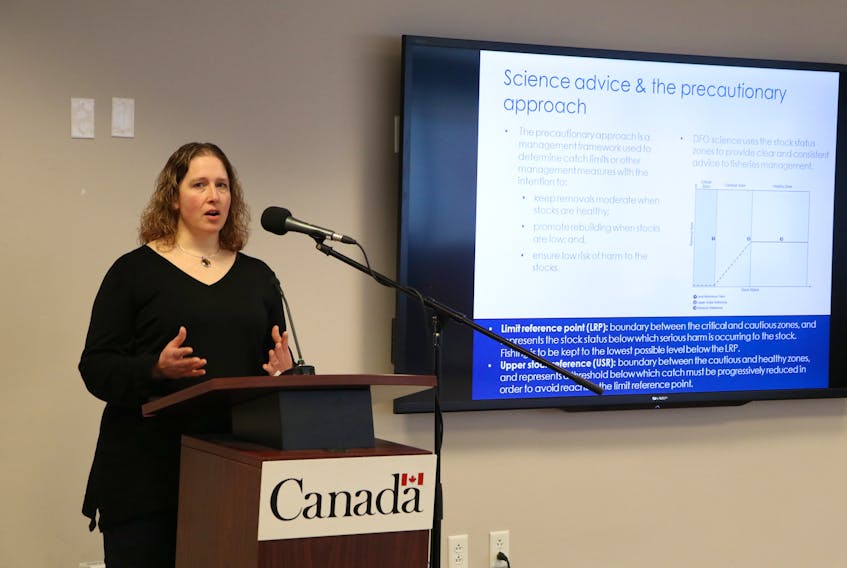Details of the latest northern shrimp stock assessment were released Friday with key Shrimp Fishing Area (SFA) 6 off the province’s northeast coast looking pretty grim.
Fishable biomass is down 16 per cent and spawning stock biomass is down 19 per cent in SFA 6, thus leaving shrimp in that area in the critical zone of the precautionary approach framework employed by Department of Fisheries and Oceans (DFO) science.
That will likely translate into another drop in the Total Allowable Catch (TAC) for the area this upcoming season as the exploitation rate of a fish stock in the critical zone should not be more than 10 per cent of the fishable biomass.
The TAC last year in SFA 6 was reduced by a whooping 62.6 per cent to 10,400 tonnes after the stock assessment revealed a 25 per cent drop in fishable biomass.
This year’s TAC won’t be announced by the federal minister until after a March 7 Northern Shrimp Advisory meeting.
At that gathering, DFO science advice will be presented and discussed with industry stakeholders and indigenous groups. Recommendations for the TAC level and any other management measures will be made following the meeting.
The Fish, Food and Allied Workers (FFAW-Unifor) responded to the news saying DFO needs to re-evaluate the reference points used to establish the stock status in SFA 6.
In a news release the union stated that DFO Science sets reference points based on the average spawning stock biomass from 1996 to 2003, a time when shrimp predators such as northern cod were at an all-time low. A rebuilding plan based on that reference period means northern shrimp will likely not recover out of the critical zone, irrespective of any fishing pressure, it stated.
“This northern shrimp assessment paints a picture of an ecosystem in transition, not simply the decline of a stock,” FFAW-Unifor president Keith Sullivan said.
“It is crucial that DFO incorporate pre-1996 biomass levels in the management of northern shrimp. Re-evaluating the reference points would help to stabilize this fishery and avoid further economic hardship in rural Newfoundland and Labrador.”
The release notes that about 3,000 people are directly employed in the inshore shrimp fishery, which together with its spinoffs, contributed $250 million to the provincial economy in 2015.
“We can’t say that it was fishing. We believe primarily it was predation that was driving it down. We see (groundfish) are eating a lot more shrimp but mainly it is because there is less caplin in the water available for them to eat. The amount of shrimp they are eating have increased for a few years and, in recent years, it has remained about the same. The groundfish population is nowhere close to where it was before the 1990s so the impacts aren’t fully understood but we know that predation by groundfish does had a big effect on the current shrimp population.”
Katherine Skanes, a stock assessment biologist with DFO
Shrimp income in 2015 made up greater than half of the total harvesting income for more than 75 per cent of harvesters, the union said. Combined with declining crab stocks and few other fisheries, the cuts are having a significant impact on the economic livelihood of thousands of people in the province.
Related stories:
Northern shrimp stocks still ‘critical’
FFAW-Unifor upset with DFO decision to draft inadequate northern shrimp plan
While SFA 6 shrimp remains in the critical zone, SFA 4 and 5 off the coast of Labrador remain in the healthy zone.
Katherine Skanes, a stock assessment biologist with DFO, explained Friday that the SFAs are managed under the precautionary approach based on the female spawning stock biomass — the changes in the overall weight, in tonnes, of the female population.
Skanes said that predation, fishing and the environment all affect shrimp production, although precise relationships are not clear. Shrimp production has declined since the mid-1990s and is expected to remain at low values for the next two-three years.
Skanes also noted that shrimp is an important forage species, particularly when there is a scarcity of caplin.
“We know that fishing is related to how much shrimp is out there but we don’t have like measures on which driver was the most significant on driving the shrimp resource down,” she said. “We can’t say that it was fishing. We believe primarily it was predation that was driving it down.
“We see (groundfish) are eating a lot more shrimp but mainly it is because there is less caplin in the water available for them to eat.
“The amount of shrimp they are eating have increased for a few years and, in recent years, it has remained about the same. The groundfish population is nowhere close to where it was before the 1990s so the impacts aren’t fully understood but we know that predation by groundfish does had a big effect on the current shrimp population.”









